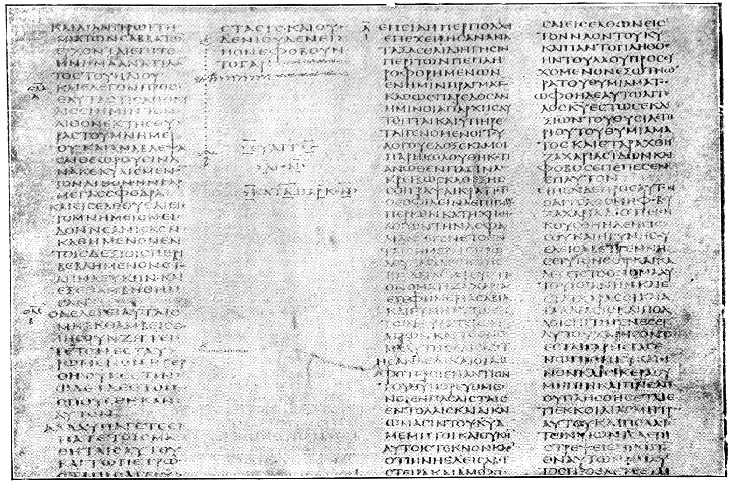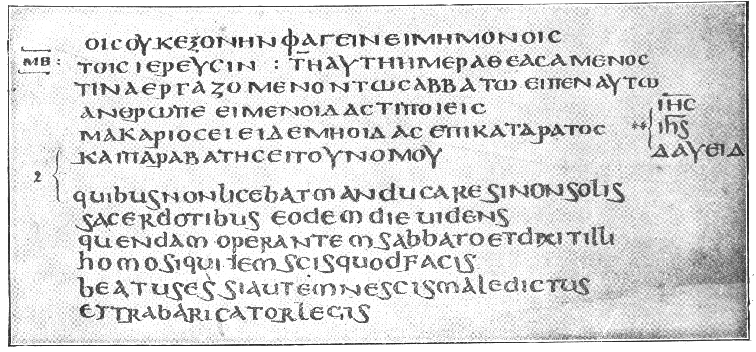![]()
Extracts From How We Got Our Bible
Islamic Awareness
© Islamic Awareness, All Rights Reserved.
Last Modified: 31st August 1999
Some interesting extracts dealing with the very old manuscripts of the Bible. This is taken from the book How We Got Our Bible, J. Paterson Smyth, Rector of Sr. George's, Montreal, Professor of Pastoral Theology in Dublin University New Edition, Largely rewritten with Additional illustrations, Twenty-Third edition, 1912. First Edition published March, 1856, London, Sampson Low, Marston & Company Limited.
The Sinaitic Manuscript
Page 20 - 21:

Now see the photographed sheet of this manuscript, at page -, showing the close of St. Mark's gospel and the beginning of St. Luke's. We have purposely chosen this part of the manuscript for illustration. We have already (page 16) mentioned the fact that the Revised Version has printed the last twelve verses of St. Mark as in some degree doubtful, and has put a notice in the margin that "the two oldest Greek Manuscripts omit these verses." This and the Vatican Manuscript are the two referred to. The evidence of the Vatican manuscript, however, is very doubtful, for though it omits these verses it leaves the whole following column blank as well as the remainder of the column on which v.8 is written. Nowhere else does it leave such a blank at the end of a book, and the fact indicates that the scribe knew of the existence of the passage and was uncertain whether to put it in or not. The evidence of the Sinaitic, however, is quite unhesitating. St. Mark's gospel evidently ends on this page as photographed, and any one who can read Greek can see in this photograph that it ends with the words EPHOBOUNTO GAR,"for they were afraid" (v. 8).
It should be interesting for the reader to be able to see the very passage on which the Revisers depend so much. This is not the place to discuss the question whether the Revisers are right or not. But we may here say that those two old manuscripts with some statements of Eusebius, the great church historian, are the only important evidence against the passage in question, while nearly all the rest of the manuscripts and most of the Versions bear testimony on the other side.
Page 23 :
Codex Bezae
There is just one more unical manuscript that deserves mention. This is Codex Bezae which is in the University Library at Cambridge. It was presented to the University in 1581, by Theodore Beza, the friend of Calvin, with a statement in his own handwriting that he had got it in 1562, from the monastery of St. Irenaius, at Lyons --(Lyons was sacked in that year). It is somewhat later in date than the other great uncials already mentioned and is written in Greek and Latin on opposite pages.
It is in many ways a curious and interesting document. It shows part of a very old Greek and a very old Latin Bible which do not always exactly correspond. It shows traces of the work of several correctors, some of them very ancient. One can see how the original scribe, whenever he made a slip, washed it out with a sponge, and how he corrected with a pen nearly empty of ink. Later correctors scraped out with a knife what seemed to them incorrect, and so have in some places spoiled the manuscript. But the most curious thing is the daring interpolations in the text, most of which are entirely unsupported by other manuscripts. Most of them are probably worthless but yet it is not improbable that some of them may contain lost sayings and deeds of Our Lord, such as St. John refers to in chapter xxi. 25, "there are also many other things which Jesus did, the which if they should be written every one I suppose that even the world itself would not contain the books that should be written."

Our photograph facing page 25 , shows a very famous one, of which even so cautious a writer as Dr. Westcott says "It is evident that it rests on some real incident." It occurs in St. Luke vi., between the fourth and fifth verses. It is in the midst of the Pharisee's disputes with Our Lord about the keeping of the Sabbath. For convenience sake the Latin is photographed underneath the Greek instead of opposite it. The reader can easily follow the Latin on the photograph.
quibus non licebat manducare si non solis sacerdotious
which it is not lawful to eat but for the priests alone.
This is the end of v.4 and then follows the interpolation:
|
EODEM DIE VIDENS QUENDAM OPERANTEM SABBATO ET DIXIT ILLI HOMO SIQUIDEM SCIS QUOD FACIS BEATUS ES. SI AUTEM NESCIS MALEDICTUS ET TRABARICATOR LEGIS. |
|
THE SAME DAY SEEING A CERTAIN MAN WORKING ON THE SABBATH HE SAID TO HIM MAN IF INDEED THOU KNOWEST WHAT THOU ART DOING HAPPY ART THOU. |
Other Articles Related To The Textual Reliability Of The Bible
Church Tradition & The Textual Integrity Of The Bible
Critical Text Of The New Testament: Methodology & Implications
| Islamic Awareness |